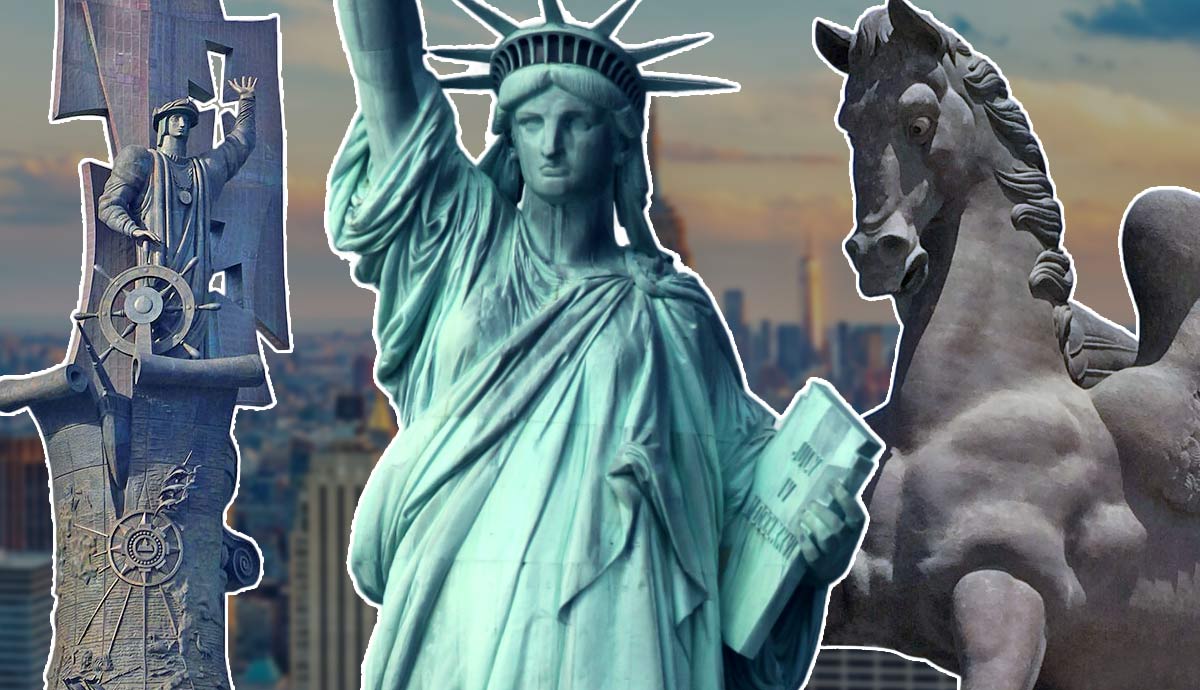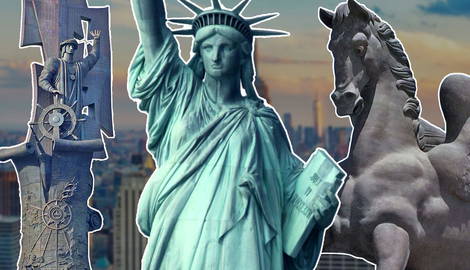
Monumental statues exist all across the United States, standing as emblems of historical events and people, or inviting us to contemplate their surroundings in some new way. Some of these public artworks have become such significant markers of place that locals have developed a close kinship with the art. Meanwhile, others are so divisive and controversial that they are reviled by locals, have become the subject of fierce and ongoing debate, or have even been defaced or destroyed. While size isn’t everything when it comes to great art, there’s no denying the tallest statues have an uncanny knack of drawing public attention, good and bad. We take a look through a handful of the tallest statues – old and new – that can be found across the United States, as an homage to the complex, and often deeply divided cultural history that continues to evolve here.
1. Birth of the New World: 360 feet

The infamous Birth of the New World has stirred up more than its fair share of controversy since its completion in 2016. Set on the Atlantic Coast of Arecibo in Puerto Rico, the statue was designed by Georgian-Russian artist Zurab Tsereteli to commemorate the 500th anniversary of Christopher Columbus’ first voyage.
The statue depicts Columbus steering a ship’s wheel, while the ships, the Nina, Pinta, and Santa Maria, can be seen in the background. Tsereteli had tried but failed to have his statue accepted by several major US cities including New York City and Columbus, but it was rejected due to its sheer size and the controversial nature of its central protagonist. Despite being accepted by Puerto Rico, the statue is mired with detractors, including many Puerto Ricans.
2. The Statue of Liberty: 151 feet

The iconic Statue of Liberty is the second tallest statue in the entire United States. Designed by French sculptor Frederic Auguste Bartholdi and completed in 1886, the statue was a gift from France to the United States, to commemorate the close union forged between France and the US during the American Revolution. Bartholdi designed the statue of Lady Liberty to resemble the Roman goddess Libertas, holding a torch high into the sky.
As such, she has become a universal symbol of liberty and freedom. In fact, the island which houses the Statue of Liberty didn’t become known as Liberty Island until 1956, despite the island’s long history as a stopping bay for quarantining new ships of immigrants arriving into the United States in search of a new life.
3. Pegasus and Dragon: 110 feet

The monumental statue of Pegasus and the Dragon reaches an impressive 110 feet high, and weighs a staggering 700 tons, making it easily the second tallest statue in the United States, and quite possibly the largest bronze horse statue in the world. Set within Gulfstream Park in California, home for a racetrack and casino, the statue was designed and constructed by the German bronze casting company Strassaker and completed in 2014 as part of a wider plan to renovate and extend the parklands.
While locals have divided opinions about the triumphant horse statue, which is illuminated with lights and lasers at night, there’s no denying that the mythological winged horse ties in with the site’s long history with horseracing.
4. Our Lady of the Rockies: 88.6 feet

Set on the peak of the Continental Divide, overlooking the city of Butte in Montana, Our Lady of the Rockies is a stainless-steel statue that soars 88.6 feet into the sky. The statue was designed by retired engineer Laurien Eugene Riehl and completed in 1985. He dedicated the statue to the Virgin Mary, and to “all women, especially mothers.”
5. Metaphor: The Tree of Utah: 87 feet

Also known as The Tree of Life, this colossal, 87-foot-high statue was created by the Swedish artist Karl Momen during the 1980s. Set within the wide-open Great Salt Lake Desert of Utah, this curious, abstracted tree sculpture was designed as a means of bringing colour and life to the barren desert where no real trees are able to grow. Made from 225 tons of cement and around 2,000 different ceramic tiles, Momen funded the production of the artwork himself, and dedicated it to the people of Utah.










